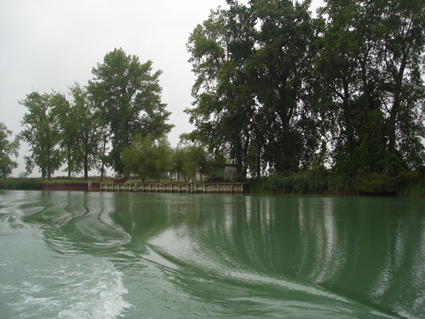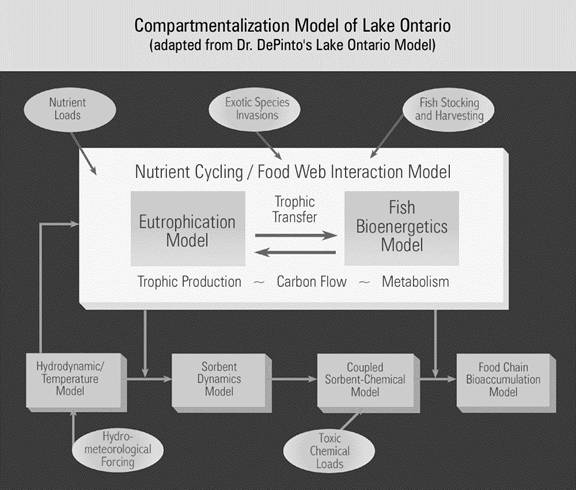|
Earlier, a point was made that we had to carry out solutions to management
problems within a decision framework. We have done this for the last 15
years starting with acid rain, where everything is done within a Decision
Support System called RAISON, (http://www.cciw.ca/nwri/software/raison.html)
developed by our group at the Environment Canada's National Water Research
Institute (NWRI).
The
Great Lakes Toxic Chemical Decision Support System (GLTCDSS) is an example
of an application which operates within RAISON. The system includes tools
such as GIS, database, statistics, neural networks, expert systems,
graphical displays, etc.
Using
his laptop computer, Bill showed the interface of the GLTCDSS. This allows
one to pick any of the Great Lakes or connecting channels, and automatically
links the user to the appropriate database tables.
Miriam Diamond mentioned that there are different types of models needed for
different systems/needs; a public user interface requires an order of
magnitude more work to program than a technical user interface.
Most
of work has been done on Lake Ontario; especially longterm monitoring by Joe
DePinto and Bill Booty. The GLTCDSS contains a number of models;
* Don
Mackay's and Miriam Diamond's regional fugacity model and * Rate Constant
mass balance model * a regional air transport model * and 2 Lake Ontario
models; LOTOX1 and LOTOX2.
The
user can go through the system, extract the necessary information, and
construct (in proper format) the data needed for the model.
All
kinds of data (emissions, loadings, and ambient) are in the database
already. We can extract data for whatever time period is necessary.
Here,
one can choose one's lake and chemical, and then assign names to files that
will be generated; for example, Lake Ontario PCBs. Here, we have all of the
key parameters and values listed. We can change rate constants and have
summary of all inputs. The same thing can be done for food chain; fish. As
well, a mass balance diagram is generated.
Having all of the tools and interfaces set up in one system, makes it easy
to quickly run different scenarios or do "gaming".
Bill
Booty then showed some results that illustrated what Joe DePinto was talking
about.
The
RATECON model operates in a number of different modes. One can carry out
steady state calculations of concentrations using loadings as inputs. It may
also be run in reverse, using measured system concentrations to calculate
what the loads should be.
For
this example, measured system concentrations for the year 1995 are used as
input to back-calculate the terrestrial loadings. It is assumed that the
atmospheric loadings are known.
The
model was initially calibrated starting with information known from the
literature and the necessary loadings were determined. Many loadings were
based initially from estimates taken from the literature. The model was then
run backwards to see what loadings would be required to generate the
measured outflow loads measured as part of the Niagara River
Upstream/Downstream Program at Fort Erie.
The
model was calibrated based on PCB loadings of 750 kg/y + 166 kg/y. from
atmospheric sources. From this, Bill predicted 34 kg/y output from the lake,
but the measured value is 219kg/y. The terrestrial load required to generate
the 219 kg/y value is calculated to be 5700 kg/y. Where's the problem (750
vs 5700)? Is it the model? The data?
Similar discrepancies occur for other compounds as well. The estimated
outflow for Hg is 325 kg/y. The observed amount is 550 kg [numbers are
conservative], assuming highest credible resuspension levels. For Benzo [a]
pyrene, the predicted level is 260 kg/y. The measured level is 150 kg/y.
Metals loadings should be an order of magnitude higher than reported to
generate the output loads that have been measured at Fort Erie. Therefore,
there must be problems either in loading estimates or in model
parameterization. There are still lots of problems. If we don't know the
loadings, we're in big trouble.
Response to Question : compartments
Bill
showed an overhead (Fig. 2) ('adapted' from Joe DePinto's model of Lake
Ontario compartmentalization model).
Missing compartments include fish, exotic species, hydrodynamic models, and
temperature. We need hydrometerological forcing functions. Much of the
function definition has been done. We need only to link the functions.
Joe
DePinto: possibly two things are happening
1.
When the measured outflow exceeds modelled outflow at steady state, the
model could be wrong. For example, perhaps the system isn't at steady state.
It may be responding to levels from 10 years ago. That doesn't help with
Lake Ontario, which is a dynamic model.
2.
The measurement data just aren't necessarily representative of what you
think is being measured. Don't automatically blame the model.
It is
also important to make sure you can't achieve a match. For example, by
adding processes that you weren't aware of before. It may be a missing load
rather than a transfer coefficient, or a short circuit in the lake. We are
always faced with dilemmas if we don't have confidence in the model. |



